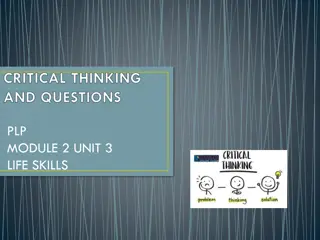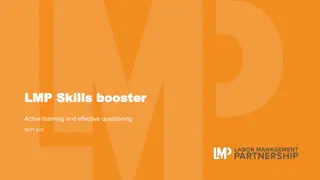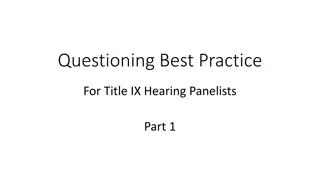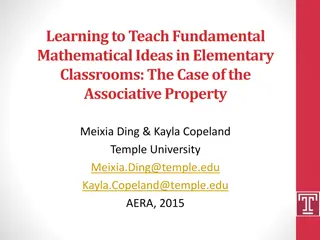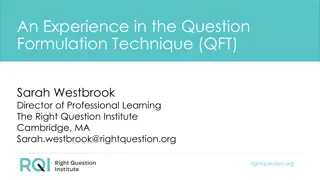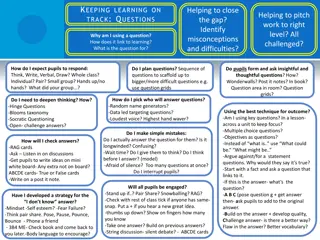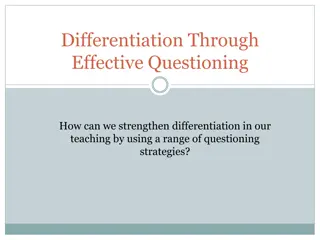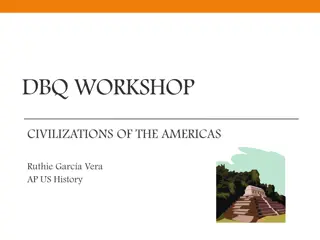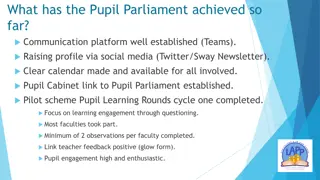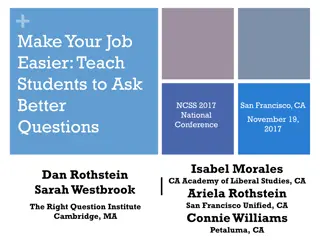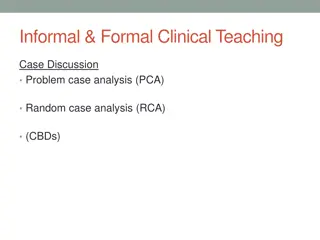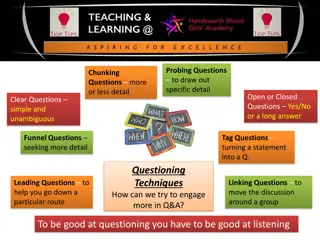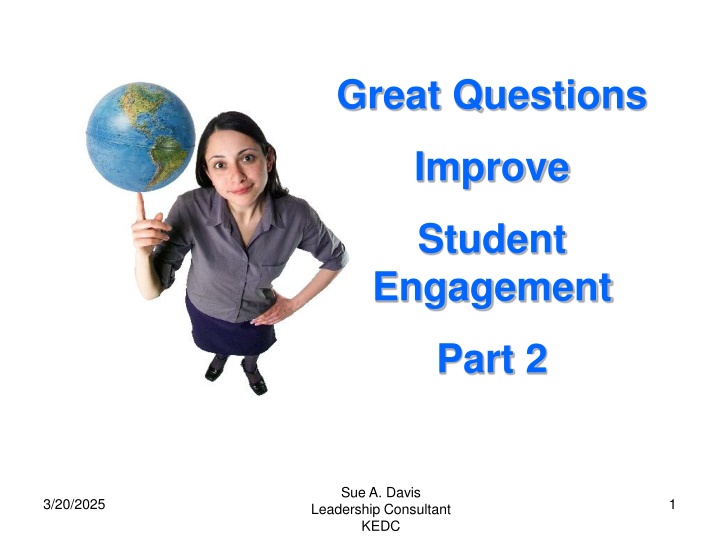
Engaging Students Through Effective Questioning Strategies
Learn about the importance of questioning in student engagement, uncovering the benefits of questioning strategies, the impact of research on instructional effectiveness, and the necessity for teachers to enhance their questioning techniques for better learning outcomes.
Uploaded on | 0 Views
Download Presentation

Please find below an Image/Link to download the presentation.
The content on the website is provided AS IS for your information and personal use only. It may not be sold, licensed, or shared on other websites without obtaining consent from the author. If you encounter any issues during the download, it is possible that the publisher has removed the file from their server.
You are allowed to download the files provided on this website for personal or commercial use, subject to the condition that they are used lawfully. All files are the property of their respective owners.
The content on the website is provided AS IS for your information and personal use only. It may not be sold, licensed, or shared on other websites without obtaining consent from the author.
E N D
Presentation Transcript
Great Questions Improve Student Engagement Part 2 Sue A. Davis Leadership Consultant KEDC 3/20/2025 1
When you see Him, What is expected of all students or What is the benefit to students. When you see Her, Questioning strategies or Teacher actions. 3/20/2025 Sue A. Davis Leadership Consultant KEDC 2
In general, research shows that instruction involving questioning is more effective than instruction without questioning. 3/20/2025 Sue A. Davis Leadership Consultant KEDC 3
Teachers often have little or no training in questioning techniques, so being familiar with the research is a good place to start. Improving in this area requires a reflective and metacognitive approach. 3/20/2025 Sue A. Davis Leadership Consultant KEDC 4
WHY ASK QUESTIONS? Teachers ask questions for a variety of purposes, including: To actively involve students in the lesson To increase motivation or interest To evaluate students preparation To check on completion of work 3/20/2025 Sue A. Davis Leadership Consultant KEDC 5
To develop critical thinking skills To review previous lessons To nurture insights To assess achievement or mastery of goals and objectives To stimulate independent learning 3/20/2025 Sue A. Davis Leadership Consultant KEDC 6
An Educative Question must be designed by the teacher 1.In view of a particular purpose 2.In consideration of a discrete content focus 3.Relative to the use of a determined level of cognition 3/20/2025 Sue A. Davis Leadership Consultant KEDC 7
Two Contexts for Oral Questioning Recitation 1. What is in question is not the thing the question asks about. 2. Answers are known before asking and confirmed after asking. 3. The questioner reacts to the answer with an evaluation as to its correctness. 3/20/2025 Sue A. Davis Leadership Consultant KEDC 8
Two Contexts for Oral Questioning Discussion 1. Questions are open for discussion rather than closed for an answer. 2. The teacher is NOT the source of the answer. 3. Discussion is characterized by an exchange of talk. 3/20/2025 Sue A. Davis Leadership Consultant KEDC 9
Purpose of Question Recitation Discussion To get students to talk To get students to think To review and assess what is known To work out understanding of content Role of Teacher Recitation Discussion Speaks at every turn Speaks in questions Evaluates the student answers as to correctness Does not speak at every turn, but yields floor to students Does not always speak in questions but also makes comments Poses question for discussion Asks questions that perplex self 3/20/2025 Sue A. Davis Leadership Consultant KEDC 10
Recitation questions should be structured so that most elicit correct responses. 3/20/2025 Sue A. Davis Leadership Consultant KEDC 11
Plan and write out the questions to be used in a lesson. How many are lower cognitive questions? Higher cognitive questions? Is the percentage appropriate for the age and ability level of your students? 3/20/2025 Sue A. Davis Leadership Consultant KEDC 12
We are not referring to questions that fill class time or that are carelessly lifted from teacher s manuals, programs, or other sources. We are referring to Educative Questions. 3/20/2025 Sue A. Davis Leadership Consultant KEDC 15
Some Cautions for our Students include: Build in the opportunity to pass Put them on the clock for extended activities (Tell them, you have 1 minute to answer correctly ) Direct Instruction / Questioning Time K-3 Less than 5 min. followed by activity or application Age + 2. 4-7 5:2 8-12 8:2 3/20/2025 Sue A. Davis Leadership Consultant KEDC 16
Time ! Use it wisely! Plan for its use. Keep kids on the clock. Quick estimate: age + 2 for attention span. Never forget your most precious resource is Time ! 3/20/2025 Sue A. Davis Leadership Consultant KEDC 17
Follow a series of steps so they can successfully respond to the question. Adjust your answer after hearing others ! Share your answer ! Keep your answer a secret! Decipher the Question ! Attend to the Question ! 3/20/2025 Sue A. Davis Leadership Consultant KEDC 18
Helping Students Who Respond Incorrectly Cue use symbols, words, 1. or phrases to help student recall Clue use overt reminders, 2. starts with , related to Probe Look for reasoning 3. behind an incorrect answer or for clarity when response is incomplete. 3/20/2025 Sue A. Davis Leadership Consultant KEDC 19
Protocols for Questioning Episodes Discussion Questions A teacher may choose any number of strategies for students to follow in order to bring about rich discussion. The most important thing here is a shift in mindset. For a true discussion to occur, the teacher cannot think that there is only one right answer or that they should lead students to a specific conclusion. The teacher must let the students talk with each other. Day One: Students prepare (research, read, write, create, experiment, design) an individual series of questions related to the chosen topic. Day Two: Students break into small groups to discuss the topic, using their own and others questions to guide the discussion. Day Three:Students meet for a shorter period of time in their small groups to discuss any thoughts they may have had since the discussion. It is the final, individual reflection sheet that is submitted to the teacher. 3/20/2025 Sue A. Davis Leadership Consultant KEDC 20
Protocols for Questioning Episodes Recitation Questions It is wonderful when a teacher asks a series of lower cognitive questions that spiral to higher levels and the students follow along. But to get there, a teacher must teach the students how to engage in the questioning session that is a part of an entire classroom period. Step One: rapid responses. Step Two: of students for their responses. Step Three: to me, not yet] or to get help [table partner, elbow partner, call a friend, check their notes] Step Four: Ask the question to the entire group, first. WAIT. Repeat the question. WAIT. Then call on a student to respond. Step Five: WAIT, making eye contact with several (if not all) students around the room. Affirm, prod, probe, clue, clarify as necessary. Design a series of questions that will generate relatively Prepare a method for guaranteeing the random selection Allow for a student to opt out for now [PASS, Come back 3/20/2025 Sue A. Davis Leadership Consultant KEDC 21
Wait Time : the time you give to a student to process information Steps: Pose the question Wait Time I: pause 3-5 seconds after posing the question Student Responds Wait Time II: pause at least 3-5 seconds after the student responds Other students complete their thinking 3/20/2025 Sue A. Davis Leadership Consultant KEDC 22
Managing Time and Wait Time 1) Improvements in student achievement 2) Increases in the number of higher cognitive responses generated by students 3) Increases in the length of student responses 4) Increases in the number of unsolicited responses 5) Decreases in students failure to respond 6) Increases in the amount and quality of evidence students offer to support their inferences 3/20/2025 Sue A. Davis Leadership Consultant KEDC 23
Managing Time and Wait Time (cont) 7) Increases in contributions by students who do not participate much when wait- time is under three seconds 8) Expansion of the variety of responses offered by students 9) Decreases in student interruptions 10)Increases in student to student interactions around content 11)Increases in the number of questions posed by students 3/20/2025 Sue A. Davis Leadership Consultant KEDC 24
Increasing Wait Time beyond 3 seconds is positively related to the following teacher outcomes: 1) Increases in flexibility of teachers responses, with teachers listening more and engaging students in more discussions 2) Increases in teacher expectations regarding students usually regarded as slow 3) Expansion of the variety of questions asked by teachers 4) Increases in the number of higher cognitive questions asked by teachers 3/20/2025 Sue A. Davis Leadership Consultant KEDC 25
Random Selection of Students for Responses to Questions Teachers who devise a way to guarantee that each and every student is on the hook for learning during either recitation or discussion questions will overtly improve student engagement. However, even on a good day, teachers have an action zone. 3/20/2025 Sue A. Davis Leadership Consultant KEDC 26
http://images.apple.com/ipad-mini/overview/images/hero.jpg Randomizer Pick Me Team Shake Others? 3/20/2025 Sue A. Davis Leadership Consultant KEDC 27
Random Selection of Students for Responses to Questions 1) Index Cards or Tongue Depressers: Write each student s name on 2 cards or tongue depressers. Shuffle or mix them together. Ask the question FIRST for the entire class. Repeat the question. Pull out a name and repeat the question for that individual. Use appropriate wait time, hear student response, and replace name back in stack or pile. Ask a second question, and pull another card. 3/20/2025 Sue A. Davis Leadership Consultant KEDC 28
Random Selection of Students for Responses to Questions 2) Numbered Desks Put a small piece of masking tape on each student desk. Number the desks by writing on the masking tape. Ask the question. Pull a number out of a hat, and that person answers. And so on. 3/20/2025 Sue A. Davis Leadership Consultant KEDC 29
Random Selection of Students for Responses to Questions 3) Numbered Heads Together >Students form small groups and number off in each group >Teacher asks a question >Students put their heads together to work out the response >Teacher calls number and students in each group with that number raise their hands >Teacher calls on one to answer 3/20/2025 Sue A. Davis Leadership Consultant KEDC 30
Other Ways for Students to Respond to Questions Signaled Response: Have every student signal the answer. Example: thumbs up if true, thumbs down if false, to the side if not sure. Work Samples: Have students write their answers (chalk or white boards, large cardstock); teacher circulates or students hold up answers. 3/20/2025 Sue A. Davis Leadership Consultant KEDC 31
Other Ways for Students to Respond to Questions Pairs Check: Students work in four- person teams (two pairs consisting of a coach and worker each). Pairs complete a short assignment that reinforces lessons, checking answers with the other half of their team. Coaches and workers trade jobs after each problem. Individual Responses: Yes, sometimes you just have to call out someone s name to bring them out of the fog. 3/20/2025 Sue A. Davis Leadership Consultant KEDC 32
Positively probing for correct answers, a teacher sees the following results. Redirection and probing (often researched together) are positively related to achievement when they are explicitly focused, e.g., on the clarity, accuracy, plausibility, etc. of student responses. Redirection and probing are unrelated to achievement when they are vague or critical, e.g., That s not right, try again; Where did you get an idea like that? I m sure Suzanne has thought it through more carefully and can help us. 3/20/2025 Sue A. Davis Leadership Consultant KEDC 33
Helping Students Who Respond Incorrectly pose the same Rephrase question in different words pose the same Redirect question to a different student; then go back to the first student for reinforcement or clarification Check Hold accountable later back later in the lesson with the student who responded incorrectly to make sure they now have the right answer. 3/20/2025 Sue A. Davis Leadership Consultant KEDC 34
What to Do if a Student Asks a Question During Recitation or Discussion If the question is relative to the learning objective, answer it. Ask yourself: 1) Who is the question for? 2) Do I know enough about it? 3) Am I ready to teach this now? 4) Is it worth abandoning what I ve planned? 3/20/2025 Sue A. Davis Leadership Consultant KEDC 35
By randomly selecting students to respond to educative questions, responding appropriately to incorrect answers and student questions, a teacher improves the opportunities for students To focus their attention and energy on the content and task at hand; To retain pertinent learning longer: To transfer the learning to other areas of experience, and To increase the rate and degree of learning. They learn faster and deeper. 3/20/2025 Sue A. Davis Leadership Consultant KEDC 36
Positively probing for correct answers, a teacher sees the following results. Redirection and probing (often researched together) are positively related to achievement when they are explicitly focused, e.g., on the clarity, accuracy, plausibility, etc. of student responses. Redirection and probing are unrelated to achievement when they are vague or critical, e.g., That s not right, try again; Where did you get an idea like that? I m sure Suzanne has thought it through more carefully and can help us. 3/20/2025 Sue A. Davis Leadership Consultant KEDC 37
Spiraling Questions from Lower Cognitive to Higher Cognitive Content and Back Again All students need to be brought into the recitation or discussion from some place (another class, a different activity, lunch, breaks, interruptions). The teacher does this by asking lower cognitive questions (prior knowledge, review, reminders) first, and then going to higher order questions with the time is right. 3/20/2025 Sue A. Davis Leadership Consultant KEDC 38
Teaching Students to Draw Inferences P.D. Pearson, in his research document Changing the Face of Reading Comprehension Instruction, defines a simple model that provides some basic steps which can help students make connections between what they know and what they are seeking to learn. 3/20/2025 Sue A. Davis Leadership Consultant KEDC 40
Teaching Students to Draw Inferences Pearson suggests teachers complete all the steps in this process by way of demonstration, then gradually shift responsibility for all but the first step to the students. 3/20/2025 Sue A. Davis Leadership Consultant KEDC 41
Teaching Students to Draw Inferences Step One: Ask the inference question. Step Two: Answer it. Step Three: Find clues in the text to support the inference. Step Four: Tell how to get from the clues to the answer (give line of reasoning). 3/20/2025 Sue A. Davis Leadership Consultant KEDC 42
Drawing appropriate inferences provides students the opportunity to Transfer learning Internalize learning as related to their working on the response Learn the process for inferring Participate in higher order activities that require the identification of patterns, items of importance, and evidence Communicate student thoughts that are closely related to core curriculum Increase the rate and degree of learning 3/20/2025 Sue A. Davis Leadership Consultant KEDC 43
Guidelines for Classroom Questioning The handout provided comes from Classroom Questioning by Kathleen Cotton from the North Western Regional Education Laboratory. She reviewed 37 research documents related to classroom questions and compiled this list after careful analysis. 3/20/2025 Sue A. Davis Leadership Consultant KEDC 44



